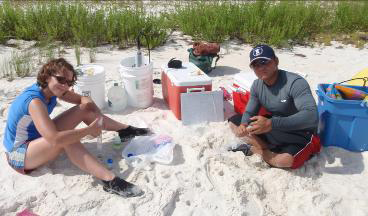Research
Investigating the Response of Seagrass Meadows to Environmental Stressors: Quantifying the Effect of Grazing on Seagrass Growth & Tissue Nutrient Content
Tissue nutrient contents (C:N:P ratios) of seagrass leaves are widely used both to infer nutrient limitation and to assess changes in nutrient availability. However, grazing of seagrass tissues may also affect these ratios and confound accurate interpretation of nutritional status. A series of manipulative experiments will determine the relative importance of bottom-up (nutrient availability) and top-down (grazing) processes in controlling nutrient content and clarify the use of nutrient ratios as indicators of availability.
Landscape Monitoring and Biological Indicators for Seagrass Conservation in Texas Coastal Waters
In an effort to assist resource managers, this research is designed to identify critical plant and water column parameters that can be used to monitor the status of valuable seagrass ecosystems threatened by human disturbance. These indicators of stress are then linked to landscape features to provide a multi-scaled approach for detecting changes in ecosystem condition prior to significant habitat loss or functional impairment.
 Student Involvement
Student Involvement
Research is an important part of the undergraduate experience and I am committed to facilitating motivated students in their pursuit of scientific discovery. Please contact me if you are interested in exploring these or other research topics.
(PHOTO) KSU students filter water samples in preparation for nutrient analysis.









